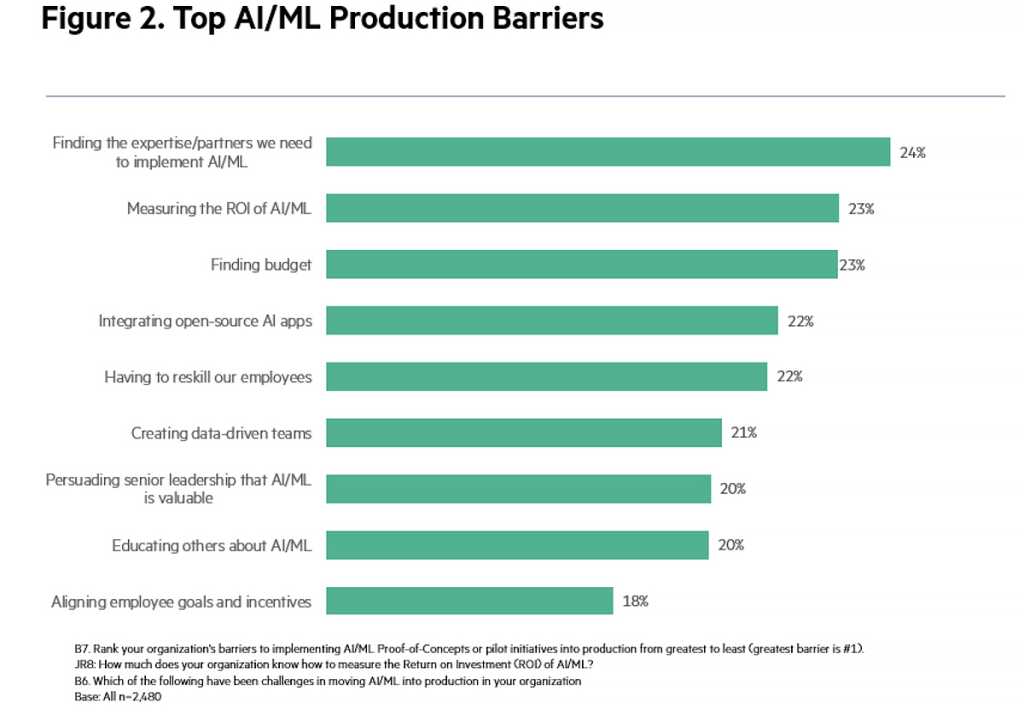- Broadcom grows revenues by 20% following VMware purchase, as customers fume about subscription costs
- How global threat actors are weaponizing AI now, according to OpenAI
- The viral Air Purifier Table is my smart home's MVP (and it's on sale for $179)
- Grab the Galaxy S25 Edge for $170 off and get a free Amazon gift card - but act fast
- How I learned to stop worrying and love my health tracker
Tactical vs. Transformative: The Changing Role of Artificial Intelligence in Digital Transformation

Today there seem to be as many AI use cases and solutions as there are business problems if not more. Artificial intelligence and machine learning (AI and ML) are no longer new to the IT, developer, or data teams. Still, starting with a common understanding helps. In general, AI is a type of software that mimics intelligent, human-like responses (voice/text recognition, image recognition, prescriptive analytics etc) to data, apps or humans. Businesses mainly use AI to automate actions or decisions. We call this machine learning when computers can accomplish this based on a learning process from the data.
Beyond tactical use cases or pilots, transformative type AI/ML initiatives can fundamentally change how businesses run, shape, and grow uncovering the new possibilities. That is what makes AI different from other technologies enabling digital transformation.
The reality of AI today is more often grounded in incremental improvements to standard business processes addressing tactical challenges. Yet, there are companies that start with small experimentation and manage to achieve more aspirational goals with more transformative programs. Why do some businesses succeed while others struggle to realize their AI value? How does technology investment and data impact successful AI strategy? HPE recently commissioned Emerald Research Group to find out why.
The study1 groups organizations based on their level of AI adaption into 3 categories as ‘developing’, ‘using’ and ‘advanced’. Characteristics of each group go very much in parallel with the level of capability these organizations show in their digital transformation journey1 For example advanced organizations (represented by 26% of respondents) are using AI in ways that have either disrupted traditional business models (20% of all organizations) or use AI as a primary method of generating business value (6% of organizations) which as key to digital transformation (Figure1).
HPE
Edge to cloud AI
According to the study 26% of these advance organizations leverage AI/ML in new ways that disrupt traditional models such as the edge to uncover actionable insights more quickly and automate responses, developing a powerful competitive advantage. 6% of these respondents see AI/ML as the primary value of their organizations. Advanced organizations bring the edge and AI together to create the intelligent edge, enabling them to outperform their competitors while organizations that wait to build an AI strategy and invest in edge solutions risk falling behind.
Also, interest in an as-a-service, cloud-type model in these organizations is higher compared to other categories. Companies that continue to embrace Cloud and as-a-service delivery models will likely benefit from AI at scale.
Barriers to success
While many developing organizations start with an exploration of needs and opportunities, and then move to an experimentation phase to show the proof of value, their move towards enterprise level AI is a different story.
In this research, organizations told us the biggest challenge is finding the right talent and expertise needed to implement their AI strategies. As organizations grow in AI sophistication, they often quickly realize they face a critical skills gap and lack expertise needed to implement their strategies.
In addition, organizations have difficulty in understanding the ROI of AI. The ability to articulate the ROI from AI investment grows as organizations mature in their AI sophistication, the struggle to quantify and measure ROI is almost universal across developing, using, and advanced organizations.
As developing and using organizations strive toward realizing their AI strategies, they tend to struggle with quick and easy access to data. Moreover, many are sceptical about the veracity of the data they work with. Organizations earlier in their AI journeys wishing to build a successful AI strategy must first address their data requirements.

HPE
Secure, flexible AIaaS
Moving AI and advanced analytics workloads to the cloud or an AIaaS model is not a trivial task especially when critical business processes and data are concerned. But organizations expect the benefits to outweigh the costs and risks once their transformation to a cloud-first AI/ML model is complete. Along the way, they will face opportunities, challenges, and decisions. The right framework provides a structure and common language to understand where they are in their journey. It also allows them to benchmark against best practices and to correctly prioritize next steps for their organization in a methodical way. Read ‘Developing and Consuming AI Use cases in Cloud’ to find out more.
The research tells us that deployment flexibility, end-to-end platform and security, and protection are their top 3 criteria in selecting an AIaaS solution. As organizations grow and mature in their AI sophistication, they look to AIaaS to maintain flexibility in where they deploy their solutions whether it is in the cloud or on-premises (Figure 3). This finding supports what we see with the AI and data client projects HPE experts deliver. Scaling AI solutions and making it available globally, enterprise ready requires continuous collaboration and feedback loop between teams, roles (IT, data, apps) and BUs on a flexible, open, secure as a service platform so that they can benefit from shared pool of organizational talent, AI models, tools, and data wherever they are.
HPE GreenLake brings the cloud experience directly to an organization’s apps and data wherever they are—edge, colocations, or data centers. With a pay-per-use, point-and-click, self-service experience that is scalable and managed, HPE GreenLake delivers services for unified analytics, high-performance compute, Big Data, MLOps, and foundational IT infrastructure workloads (compute, storage, virtualization).
Security and protection in an AIaaS solution are considered table stakes. In fact, the data suggests that the more organizations progress and realize their AI strategies, the need for security and protection increases. Find out more on Cultivating trust in AI
Figure 3: Interest in AIaaS

HPE
Advanced organizations have learned the value of end-to-end AI solutions that scale easily. In addition, they seek end-to-end solutions that encompass the following:
- Advisory and professional services
- Configurations
- Consumption models
- Financing
- Technical support services
- Security and protection
In summary advanced organizations
- Are strong believers in edge-to-cloud AI solutions
- Are much more likely to think that edge computing is essential or important to achieving the AI goals
- Believe that having end-to-end AI solutions is either a must-have or a key part of success with AI
- Have interest in AIaaS because they want to benefit from cloud capabilities
- Prioritize an edge-to-cloud architecture as a criteria, when selecting AI services
To read more of about the research access the full report from Emerald Research Group report (HPE commissioned) at https://www.hpe.com/psnow/doc/a50005016enw
To find out more about Digital Next Advisory or engaging with an HPE Digital Advisor please contact us at digitaladvisors@hpe.com or visit www.hpe.com/digitaltransformation
The AI Journey: Going from practical to transformative, Emerald Research Group, sponsored by HPE¹ https://www.hpe.com/psnow/doc/a50005016enw
____________________________________
About Hande Sahin-Bahceci

HPE
In her global role based in London, UK, Hande leads the marketing of data and artificial intelligence services for HPE GreenLake Edge to Cloud Platform. Hande has 20+ years of technology and marketing experience as a consultant, portfolio and marketing manager. Hande has passion for emerging technologies and their impact on organizations, societies and ethics.
E-mail: hande.sahin-bahceci@hpe.com
Follow: Linked-In , Twitter , HPE AI Blogs
Websites: https://hpe.com/greenlake, https://hpe.com/AI

